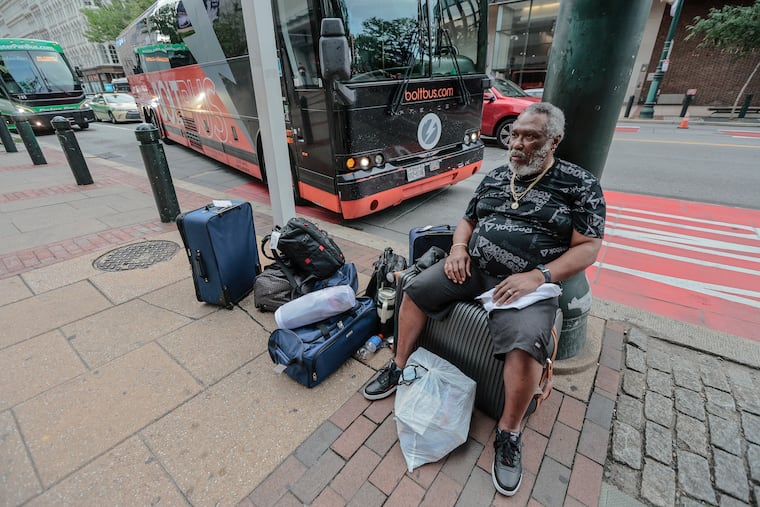Relocated bus terminal makes a bad situation worse | Editorial
Moving bus operations away from the heart of Center City makes the failure of city government less visible, if no less appalling.

After outcry over what critics called a humanitarian disaster and a municipal disgrace, Philadelphia’s curbside bus terminal is moving from Sixth and Market Streets — an ill-equipped location that left travelers with nowhere to sit, no shelter from inclement weather, and no restroom access.
Shamefully, the new bus station at Spring Garden Street at Christopher Columbus Boulevard is an even worse option.
Until earlier this year, the city’s intercity riders could wait at the bus terminal at 10th and Filbert Streets, which came equipped with ticket booths, bathrooms, seating, power outlets, and shelter.
While that terminal never inspired much in the way of praise, it was a functional place to wait for the bus and offered quick access to other forms of transportation — including Regional Rail, PATCO, and trolleys — a short walk away.
The nearby Fashion District mall and Chinatown businesses also afforded riders an opportunity to grab a quick meal or relax between trips.
The rise of new companies like Megabus disrupted this arrangement. Unlike traditional carriers, Megabus skipped the bus terminal experience and the upkeep costs associated with using it. This allowed it to charge lower fares than terminal-based companies like Greyhound.
When German-based Flixbus bought Greyhound in 2021, it sold the acquired carrier’s network of stations and closed the Filbert Street terminal in June. Flixbus and its aligned carriers laid off the station’s employees and moved their operations to the 600 block of Market Street.
This made life harder for bus riders, who were quite literally kicked to the curb.
It quickly became apparent that this situation wasn’t going to work in the long term. The new location left passengers exposed to the elements. Nearby stores quickly placed signs warning against loitering and declaring their bathrooms off-limits. And groups of people, many with luggage in tow, crowded the sidewalk just a few hundred feet from the Liberty Bell.
According to city officials, the bus station’s move from Market Street was prompted by complaints from workers in nearby office buildings, including the James A. Byrne U.S. Courthouse.
» READ MORE: Philly’s civic rebound is sure to fall short if the city fails at basic public services | Editorial
But by moving the station to a remote location, Greyhound patrons could be more vulnerable to street crime.
Instead of boarding a bus by a busy city intersection with access to every major fixed-route transit line in the region, riders are now marooned in a more desolate location. The new station’s most significant neighbor is a strip mall that features a dry cleaner and a gentleman’s club.
While the Spring Garden stop on the Market-Frankford El line is nearby, it lacks elevators, meaning any rider with accessibility needs won’t be able to use it. Considering Greyhound and other bus services cater to people who don’t own cars or can’t drive themselves, this is a serious misstep.
The lack of amenities continues at the new location. There is nowhere to sit or use the restroom, and unless your bus is assigned to the pickup area under I-95, there’s no shelter, either. Instead of making bus riders’ experience better and safer, the approach is more along the lines of “out of sight, out of mind.”
Certainly, moving bus operations makes the failure of city government (and federal regulators, who watched as Megabus captured the most profitable routes and passengers while doing little to preserve essential services) less visible, if no less appalling.
But bus riders deserve better than simply being pushed out of view. As city officials work to secure a more permanent location into early 2024, they must consider giving travelers a safe and accessible terminal.
An ideal location would be near William H. Gray III 30th Street Station. This would allow bus riders to wait inside and utilize the public facilities. Megabus already uses the station as its primary hub in the city.
Another alternative is the Philadelphia Parking Authority garage at Second and Sansom Streets, which contains a bus parking entrance. Unlike the Spring Garden site, both locations have accessible transit stations nearby. They also have more foot traffic at night, which leaves passengers less vulnerable.
It may be too late to expect much thoughtfulness or sense of purpose from the Kenney administration. That means it falls to Mayor-elect Cherelle Parker to find a solution that treats the city’s Greyhound riders with the respect and dignity they deserve.